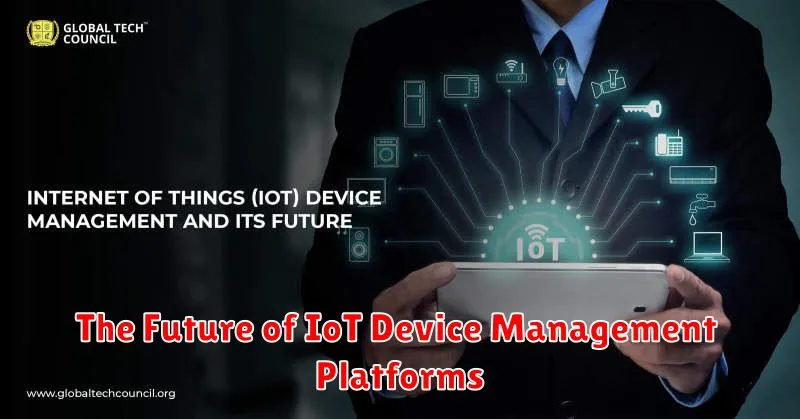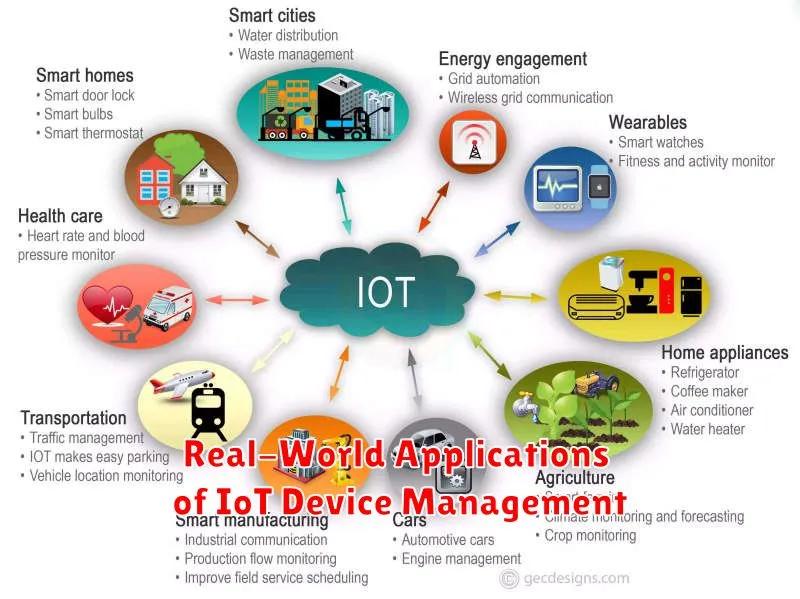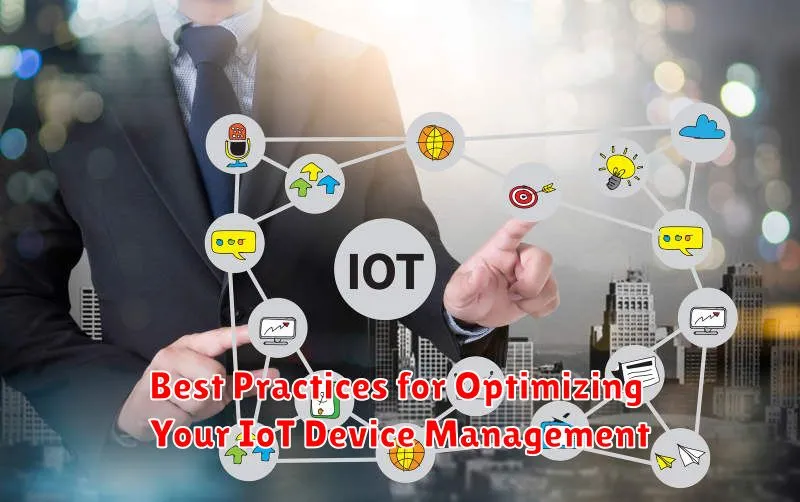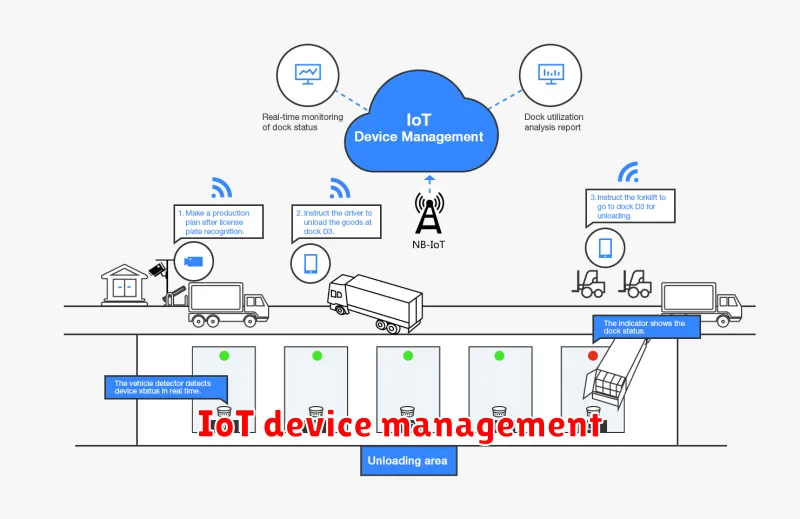The Internet of Things (IoT) has exploded in recent years, connecting billions of devices across various industries and transforming the way we live, work, and interact with the world around us. From smart homes and wearables to industrial automation and smart cities, the IoT is rapidly changing the landscape of technology. With the growing number of connected devices comes a significant challenge: managing the complexity of these interconnected systems.
Effective IoT device management is crucial for ensuring the security, reliability, and efficiency of your IoT infrastructure. But navigating the vast landscape of available platforms can be daunting. This comprehensive guide will provide you with everything you need to understand IoT device management platforms, their key features, and how to choose the right platform for your specific needs. We’ll explore the essential components, discuss the benefits of effective device management, and guide you through the process of selecting the best platform for your IoT ecosystem.
Understanding the Basics of IoT Device Management
The Internet of Things (IoT) is rapidly transforming the way we live, work, and interact with the world around us. With billions of connected devices generating vast amounts of data, managing these devices effectively becomes paramount. This is where IoT device management platforms come into play, providing the essential tools and infrastructure to ensure smooth operation, security, and scalability of your IoT ecosystem.
At its core, IoT device management encompasses a set of processes and technologies that allow you to monitor, control, and update connected devices throughout their lifecycle. It involves various aspects, including:
- Device provisioning: Setting up and configuring new devices to join your IoT network.
- Device monitoring: Tracking device performance, health, and resource usage in real time.
- Device control: Sending commands and configurations to devices, enabling remote management and automation.
- Firmware updates: Distributing and deploying software updates to devices to ensure optimal performance and security.
- Security management: Implementing security policies, managing access controls, and detecting threats to protect your IoT network.
- Data analytics: Gathering and analyzing data from devices to gain insights and optimize operations.
Understanding these fundamental aspects of IoT device management is essential for any organization looking to leverage the power of the IoT effectively. Without proper management, your IoT devices might be vulnerable, inefficient, and ultimately, hinder your overall business goals.
Key Features of Effective IoT Device Management Platforms
In the ever-evolving landscape of the Internet of Things (IoT), effective device management is crucial for ensuring seamless operations, optimal performance, and long-term sustainability. As IoT deployments grow in scale and complexity, relying on robust device management platforms becomes essential.
Here are some key features of effective IoT device management platforms that empower organizations to effectively manage their connected devices:
- Centralized Device Inventory: A comprehensive and up-to-date inventory of all connected devices is fundamental for effective management. This includes device types, models, firmware versions, and deployment locations.
- Remote Device Configuration and Provisioning: The ability to configure and provision devices remotely simplifies deployment and reduces the need for manual intervention. This feature streamlines the onboarding process and ensures consistency across the fleet.
- Firmware Updates and Patch Management: Regularly updating firmware is critical for maintaining security, addressing vulnerabilities, and enhancing device performance. Effective platforms enable scheduled and automated firmware updates across the entire device fleet.
- Real-time Monitoring and Analytics: Comprehensive monitoring capabilities provide valuable insights into device health, performance metrics, and potential issues. Real-time data analysis facilitates proactive maintenance and problem resolution.
- Security and Access Control: Robust security measures are paramount in IoT environments. Effective platforms offer features such as device authentication, encryption, and access control to safeguard sensitive data and prevent unauthorized access.
- Alerting and Notifications: Prompt notifications for critical events, such as device failures, security breaches, or performance anomalies, enable timely intervention and minimize downtime.
- Scalability and Flexibility: IoT deployments can expand rapidly. Therefore, platforms need to be scalable and adaptable to accommodate growing device counts and evolving requirements.
By leveraging platforms that encompass these key features, organizations can effectively manage their IoT deployments, optimize device performance, enhance security, and ensure long-term operational efficiency. This ultimately contributes to realizing the full potential of IoT initiatives and unlocking valuable business insights from connected devices.
Benefits of Implementing an IoT Device Management Platform
In today’s interconnected world, the Internet of Things (IoT) is revolutionizing industries and transforming how we live and work. As the number of connected devices explodes, managing these devices efficiently and effectively becomes paramount. This is where IoT device management platforms come into play, providing a centralized solution for overseeing and optimizing your IoT ecosystem.
Implementing an IoT device management platform offers numerous benefits, significantly impacting your organization’s operational efficiency, security, and overall success.
Enhanced Device Management
An IoT device management platform provides a comprehensive framework for managing your entire fleet of connected devices. From provisioning and configuration to firmware updates and security patches, the platform streamlines all aspects of device lifecycle management, ensuring optimal performance and reliability.
Improved Security Posture
Security is paramount in the IoT landscape, and a device management platform plays a crucial role in protecting your connected devices. The platform enables you to enforce access control, implement encryption protocols, and monitor device behavior for suspicious activity. By centralizing security measures, you mitigate vulnerabilities and protect your valuable data.
Data-Driven Insights
IoT devices generate vast amounts of data, which can be leveraged to gain valuable insights into your operations. An IoT device management platform facilitates data collection, analysis, and visualization, empowering you to identify trends, optimize processes, and make data-driven decisions.
Reduced Operational Costs
By automating device management tasks and providing real-time monitoring capabilities, an IoT device management platform can significantly reduce operational costs. The platform streamlines processes, minimizes downtime, and optimizes resource allocation, leading to cost savings and increased efficiency.
Scalability and Flexibility
As your IoT ecosystem expands, the platform scales seamlessly, ensuring that you can manage a growing number of devices without compromising performance. The platform’s flexibility allows you to adapt to changing needs and integrate with various technologies, providing long-term scalability and adaptability.
In conclusion, implementing an IoT device management platform is essential for organizations looking to leverage the power of the IoT effectively. The benefits, including enhanced device management, improved security, data-driven insights, reduced costs, and scalability, make it a strategic investment that can drive growth, efficiency, and success.
Top Considerations When Choosing an IoT Device Management Platform
In the rapidly evolving landscape of the Internet of Things (IoT), effective device management is paramount. Choosing the right IoT device management platform is crucial for ensuring seamless operation, security, and scalability of your connected ecosystem. To make an informed decision, consider these key factors:
1. Scalability and Flexibility: As your IoT deployment grows, your platform should effortlessly accommodate the increasing number of devices and data streams. Look for solutions with flexible architectures that can scale horizontally and vertically to meet your future needs.
2. Security Features: Security is a fundamental concern in IoT. The chosen platform should offer robust security features, including encryption, authentication, access control, and secure firmware updates, to protect your devices and sensitive data from threats.
3. Device Management Capabilities: The platform should provide comprehensive device management capabilities, such as provisioning, configuration, monitoring, and remote control. It should support a wide range of device types and communication protocols to cater to your diverse IoT ecosystem.
4. Data Analytics and Insights: Leverage the power of data analytics to extract meaningful insights from your connected devices. Choose a platform that offers real-time data visualization, historical trend analysis, and actionable insights to optimize your IoT operations.
5. Integration and Ecosystem: Consider the platform’s integration capabilities with existing systems, such as enterprise resource planning (ERP) or customer relationship management (CRM) solutions. Look for platforms with open APIs that enable seamless data exchange.
6. User Experience and Interface: A user-friendly interface simplifies device management tasks and promotes adoption among various stakeholders. The platform should provide intuitive dashboards, clear visualizations, and easy-to-use tools.
7. Support and Documentation: Choose a platform with comprehensive documentation, training resources, and responsive technical support to ensure smooth implementation and ongoing maintenance.
By carefully considering these factors, you can select an IoT device management platform that meets your specific requirements and empowers you to successfully manage and leverage your connected devices for business growth and innovation.
Integrating Security into Your IoT Device Management Strategy
In the vast and rapidly evolving landscape of the Internet of Things (IoT), security is paramount. As the number of connected devices explodes, ensuring the safety and integrity of these devices becomes increasingly crucial. A robust device management platform forms the bedrock of a secure IoT ecosystem, providing the tools and mechanisms to safeguard your connected assets.
Integrating security into your IoT device management strategy is not a mere afterthought; it’s a fundamental design principle. Here’s a breakdown of key considerations:
Secure Device Provisioning and Onboarding
The initial stage of device onboarding is a critical security checkpoint. A robust platform will enforce secure provisioning practices, including:
- Certificate Management: Issuing and managing digital certificates to authenticate devices and ensure secure communication channels.
- Secure Boot: Verifying that devices boot with trusted software, preventing malicious firmware from being loaded.
- Access Control: Restricting access to devices and their data based on defined roles and permissions.
Real-time Monitoring and Threat Detection
Continuous monitoring is essential to detect and respond to security threats promptly. Effective platforms provide:
- Anomaly Detection: Identifying unusual device behavior that might indicate malicious activity.
- Vulnerability Scanning: Regularly scanning for known security vulnerabilities in devices and software.
- Security Event Logging: Capturing and analyzing security-related events for forensic investigations and incident response.
Secure Firmware Updates and Patching
Vulnerabilities are constantly discovered, making timely software updates crucial. A robust device management platform simplifies the update process:
- Automated Updates: Distributing security patches and firmware updates to devices in a controlled manner.
- Version Control: Maintaining a record of installed software versions for traceability and accountability.
- Rollback Capabilities: Allowing for the reversal of updates in case of unforeseen issues.
Data Encryption and Secure Communication
Protecting sensitive data is paramount. Your platform should incorporate:
- Data Encryption at Rest: Encrypting data stored on devices and in the cloud.
- Data Encryption in Transit: Encrypting data during transmission between devices, the platform, and other systems.
- Secure Communication Protocols: Utilizing protocols like TLS/SSL to ensure secure communication channels.
Conclusion
Integrating security into your IoT device management strategy is not optional. It’s the foundation for a safe, reliable, and trustworthy connected environment. By adopting a comprehensive approach that encompasses secure provisioning, monitoring, updates, and data protection, you can mitigate risks and unlock the full potential of your IoT initiatives.
The Future of IoT Device Management Platforms

The Internet of Things (IoT) is rapidly evolving, with billions of connected devices generating vast amounts of data. As the number of IoT devices continues to grow, managing and securing them becomes increasingly complex. This is where IoT device management platforms come into play. They are crucial for streamlining operations, optimizing performance, and ensuring the security of connected devices.
The future of IoT device management platforms is characterized by several key trends:
- AI-powered automation: Artificial intelligence (AI) will play a more prominent role in automating device management tasks, such as device provisioning, updates, and troubleshooting. This will free up IT teams to focus on more strategic initiatives.
- Edge computing: As more devices are deployed at the edge of the network, edge computing will become essential for real-time data processing and decision-making. IoT device management platforms will need to integrate seamlessly with edge computing environments.
- Enhanced security: Security will continue to be a paramount concern for IoT deployments. Device management platforms will need to offer robust security features, such as encryption, access control, and threat detection.
- Cloud-based solutions: Cloud-based IoT device management platforms will gain even greater traction, offering scalability, flexibility, and cost-effectiveness. These platforms will provide a centralized hub for managing devices from anywhere in the world.
- Increased interoperability: Interoperability between different devices and platforms will be crucial for seamless IoT deployments. Device management platforms will need to support a wide range of protocols and standards.
As IoT deployments become more sophisticated, device management platforms will play an increasingly critical role in enabling businesses to leverage the full potential of connected devices. By embracing these trends, organizations can ensure that their IoT initiatives are secure, scalable, and efficient.
Scalability and Flexibility for Growing IoT Deployments

As your IoT deployment scales, you need a device management platform that can keep pace. Scalability ensures your platform can handle increasing numbers of devices, data volumes, and user activity without performance degradation. Flexibility means your platform can adapt to changing needs and integrate with existing systems, allowing you to add new device types, functionalities, and use cases.
A scalable and flexible platform offers several key benefits for growing IoT deployments:
- Cost-effectiveness: Avoid overpaying for infrastructure that’s not fully utilized. Scale up or down resources as needed to match actual usage.
- Improved performance: Ensure smooth operation even as your device count grows, avoiding bottlenecks and performance degradation.
- Enhanced security: Manage security policies and updates effectively across a large number of devices.
- Increased agility: Quickly adapt to changing market demands and incorporate new technologies without major platform overhauls.
- Long-term viability: Build a foundation for future growth and expansion, enabling you to seamlessly add new devices and applications.
When choosing a device management platform, consider these factors to ensure scalability and flexibility:
- Cloud-based architecture: Provides inherent scalability and allows for easy access and management from anywhere.
- Microservices architecture: Enables independent scaling of different platform components, optimizing resource allocation.
- API-first approach: Facilitates integration with existing systems and custom applications, fostering flexibility and extensibility.
- Modular design: Allows for customization and addition of new features as your needs evolve.
- Strong community support: Access to a vibrant ecosystem of developers and partners who can provide solutions and guidance.
Investing in a scalable and flexible device management platform is crucial for navigating the evolving IoT landscape. It empowers you to manage growing deployments efficiently, adapt to changing requirements, and unlock new possibilities for innovation.
Real-World Applications of IoT Device Management

IoT device management goes beyond the initial deployment and setup. It’s a continuous process of monitoring, updating, and securing these devices throughout their lifecycle. This comprehensive approach plays a crucial role in ensuring optimal performance, reliability, and security of connected devices.
Let’s delve into some real-world examples of how IoT device management platforms are making a difference:
- Smart Cities: Imagine a city where streetlights automatically adjust their brightness based on traffic flow, and sensors monitor air quality in real time. This interconnected network of devices requires a robust IoT device management platform for seamless operation. It enables remote control, firmware updates, and data analytics to optimize resource allocation and enhance public safety.
- Healthcare: In healthcare, IoT devices are transforming patient care. Remote patient monitoring systems, wearable devices, and connected medical equipment are collecting valuable data to improve diagnosis, treatment, and overall health outcomes. Effective IoT device management ensures the secure exchange of sensitive health information, facilitates timely updates, and guarantees the reliable functioning of these critical devices.
- Industrial Automation: Manufacturing processes are being revolutionized by interconnected sensors, robots, and machines. IoT device management enables remote monitoring of production lines, predictive maintenance, and real-time performance optimization. By collecting data from various devices, manufacturers gain valuable insights to improve efficiency, minimize downtime, and enhance product quality.
- Retail: Smart shelves with sensors track inventory levels, optimize stock management, and provide real-time insights into customer behavior. IoT device management ensures the reliable operation of these connected systems, facilitating efficient order fulfillment and personalized shopping experiences.
The applications of IoT device management are vast and continue to expand as the IoT ecosystem evolves. By providing a comprehensive framework for managing connected devices, these platforms are driving innovation, improving efficiency, and enhancing the overall value of the Internet of Things.
Case Studies: Successful Implementations of IoT Device Management
Implementing an effective IoT device management platform is essential for any organization looking to leverage the power of the Internet of Things. But beyond the theoretical benefits, it’s helpful to see how real companies have achieved success in this area. Here are a few case studies showcasing how organizations have successfully implemented IoT device management solutions:
Case Study 1: Smart City Infrastructure
A major metropolitan city implemented an IoT device management platform to manage its smart streetlights. This platform allowed the city to remotely monitor and control the lights, optimizing energy consumption and reducing maintenance costs. The platform also provided real-time data on streetlight performance, enabling the city to identify and address potential issues quickly.
Case Study 2: Industrial Automation
A large manufacturing company implemented an IoT device management platform to manage its industrial equipment. This platform enabled the company to remotely monitor and control equipment performance, reducing downtime and improving efficiency. The platform also provided valuable insights into equipment health, allowing the company to schedule preventative maintenance and avoid costly breakdowns.
Case Study 3: Healthcare Monitoring
A healthcare provider implemented an IoT device management platform to manage wearable health devices for patients. This platform allowed the provider to remotely monitor patient health data, enabling early detection of potential health issues and more proactive care. The platform also provided secure data storage and access controls, ensuring patient privacy and data security.
These case studies demonstrate the transformative potential of IoT device management platforms across diverse industries. By streamlining device deployment, monitoring, and management, these platforms empower organizations to unlock new levels of efficiency, optimization, and innovation.
Best Practices for Optimizing Your IoT Device Management

In the ever-expanding realm of the Internet of Things (IoT), effective device management is paramount for achieving optimal performance, security, and scalability. As the number of connected devices proliferates, organizations face the challenge of efficiently managing these assets throughout their lifecycle. To navigate this complex landscape, adopting a robust and comprehensive approach to device management is essential. This article delves into best practices that will empower businesses to optimize their IoT device management strategies.
1. Centralized Device Inventory and Configuration: Establishing a centralized repository for all connected devices is crucial. This inventory should encompass detailed information about each device, including its type, location, firmware version, and connectivity status. This centralized platform facilitates comprehensive device management, enabling organizations to track, monitor, and configure devices effectively.
2. Automated Device Provisioning and Onboarding: Streamlining the provisioning and onboarding processes is vital for scaling IoT deployments. Automating these tasks eliminates manual intervention, reducing errors and accelerating deployment time. Implement tools and processes that automate device registration, configuration, and connection to the network, ensuring a seamless and efficient onboarding experience.
3. Real-time Monitoring and Alerting: Continuously monitoring device health and performance is critical for proactive maintenance and issue resolution. Implementing real-time monitoring solutions enables organizations to track key performance indicators (KPIs), identify anomalies, and receive timely alerts for critical events. This proactive approach minimizes downtime and ensures optimal device operation.
4. Secure Firmware Updates and Patch Management: Maintaining up-to-date firmware is essential for addressing security vulnerabilities and enhancing device functionality. Implement a robust firmware update and patch management system that automatically delivers security patches and feature upgrades to devices. This ensures that devices remain secure and operate at peak performance.
5. Scalable and Flexible Architecture: The IoT landscape is constantly evolving, necessitating a device management platform that can adapt to changing requirements. Opt for a scalable and flexible architecture that can accommodate growth in the number of connected devices and support diverse device types. This ensures that the management platform remains effective as your IoT deployment expands.
6. Data Analytics and Insights: Leverage the wealth of data generated by connected devices to gain valuable insights into device performance, user behavior, and operational efficiency. Implement data analytics tools that can process and interpret this data, providing actionable intelligence to optimize device management strategies and improve business outcomes.
7. Comprehensive Security Measures: Security is paramount in the IoT ecosystem. Implement comprehensive security measures, including access control, encryption, and authentication protocols, to safeguard sensitive data and prevent unauthorized access to devices. This ensures the integrity and reliability of your IoT infrastructure.
By embracing these best practices, organizations can effectively manage their IoT devices throughout their lifecycle, ensuring optimal performance, security, and scalability. As the IoT landscape continues to evolve, adopting a robust device management approach will be paramount for unlocking the full potential of connected technologies and achieving business success.
Addressing Common Challenges in IoT Device Management

The Internet of Things (IoT) has revolutionized various industries, but managing a vast network of interconnected devices comes with its own set of challenges. As the number of IoT devices continues to grow exponentially, effective device management becomes crucial for organizations to ensure smooth operations, optimize performance, and mitigate potential risks.
One of the most significant challenges is device heterogeneity. IoT deployments often involve devices from different manufacturers, operating systems, and communication protocols. This diversity makes it difficult to manage devices centrally and can lead to compatibility issues. Another critical challenge is security. With a large number of devices connected to the internet, vulnerabilities can easily be exploited by malicious actors.
Scalability is another concern. As the number of devices increases, managing them manually becomes unsustainable. Organizations need scalable solutions that can handle the growing demand without compromising performance. Additionally, device provisioning and onboarding can be complex and time-consuming.
Furthermore, device monitoring and maintenance are essential to ensure optimal performance and prevent downtime. Keeping track of device health, identifying potential issues, and implementing timely updates are crucial tasks.
To effectively address these challenges, organizations need comprehensive IoT device management platforms. These platforms provide a centralized hub for managing all aspects of the IoT ecosystem, including:
- Device provisioning and onboarding
- Security management
- Data collection and analytics
- Remote monitoring and control
- Firmware updates and maintenance
By adopting robust IoT device management platforms, organizations can overcome the challenges associated with managing a large number of connected devices, ensuring secure and efficient operations. This, in turn, enables businesses to unlock the full potential of the IoT and achieve their desired outcomes.

